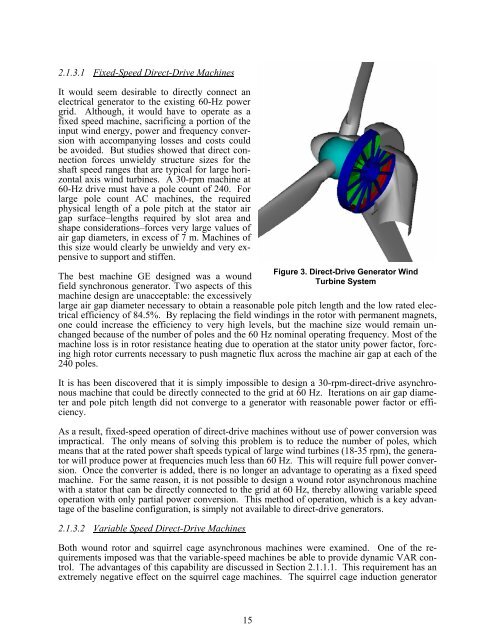Advanced Wind Turbine Program Next Generation Turbine ... - NREL
Advanced Wind Turbine Program Next Generation Turbine ... - NREL
Advanced Wind Turbine Program Next Generation Turbine ... - NREL
You also want an ePaper? Increase the reach of your titles
YUMPU automatically turns print PDFs into web optimized ePapers that Google loves.
2.1.3.1 Fixed-Speed Direct-Drive Machines<br />
It would seem desirable to directly connect an<br />
electrical generator to the existing 60-Hz power<br />
grid. Although, it would have to operate as a<br />
fixed speed machine, sacrificing a portion of the<br />
input wind energy, power and frequency conversion<br />
with accompanying losses and costs could<br />
be avoided. But studies showed that direct connection<br />
forces unwieldy structure sizes for the<br />
shaft speed ranges that are typical for large horizontal<br />
axis wind turbines. A 30-rpm machine at<br />
60-Hz drive must have a pole count of 240. For<br />
large pole count AC machines, the required<br />
physical length of a pole pitch at the stator air<br />
gap surface–lengths required by slot area and<br />
shape considerations–forces very large values of<br />
air gap diameters, in excess of 7 m. Machines of<br />
this size would clearly be unwieldy and very expensive<br />
to support and stiffen.<br />
Figure 3. Direct-Drive Generator <strong>Wind</strong><br />
The best machine GE designed was a wound<br />
<strong>Turbine</strong> System<br />
field synchronous generator. Two aspects of this<br />
machine design are unacceptable: the excessively<br />
large air gap diameter necessary to obtain a reasonable pole pitch length and the low rated electrical<br />
efficiency of 84.5%. By replacing the field windings in the rotor with permanent magnets,<br />
one could increase the efficiency to very high levels, but the machine size would remain unchanged<br />
because of the number of poles and the 60 Hz nominal operating frequency. Most of the<br />
machine loss is in rotor resistance heating due to operation at the stator unity power factor, forcing<br />
high rotor currents necessary to push magnetic flux across the machine air gap at each of the<br />
240 poles.<br />
It is has been discovered that it is simply impossible to design a 30-rpm-direct-drive asynchronous<br />
machine that could be directly connected to the grid at 60 Hz. Iterations on air gap diameter<br />
and pole pitch length did not converge to a generator with reasonable power factor or efficiency.<br />
As a result, fixed-speed operation of direct-drive machines without use of power conversion was<br />
impractical. The only means of solving this problem is to reduce the number of poles, which<br />
means that at the rated power shaft speeds typical of large wind turbines (18-35 rpm), the generator<br />
will produce power at frequencies much less than 60 Hz. This will require full power conversion.<br />
Once the converter is added, there is no longer an advantage to operating as a fixed speed<br />
machine. For the same reason, it is not possible to design a wound rotor asynchronous machine<br />
with a stator that can be directly connected to the grid at 60 Hz, thereby allowing variable speed<br />
operation with only partial power conversion. This method of operation, which is a key advantage<br />
of the baseline configuration, is simply not available to direct-drive generators.<br />
2.1.3.2 Variable Speed Direct-Drive Machines<br />
Both wound rotor and squirrel cage asynchronous machines were examined. One of the requirements<br />
imposed was that the variable-speed machines be able to provide dynamic VAR control.<br />
The advantages of this capability are discussed in Section 2.1.1.1. This requirement has an<br />
extremely negative effect on the squirrel cage machines. The squirrel cage induction generator<br />
15
















